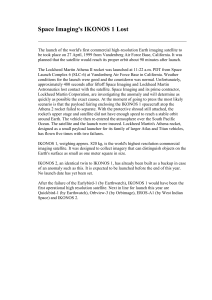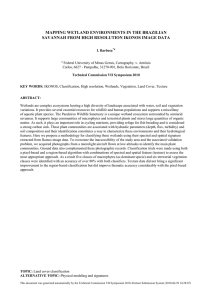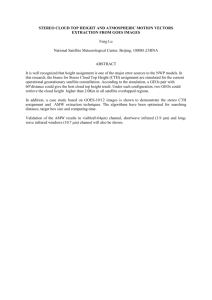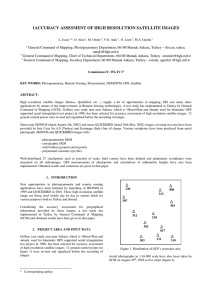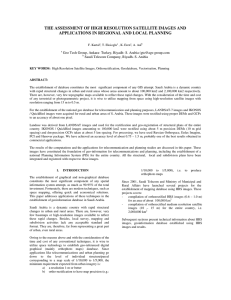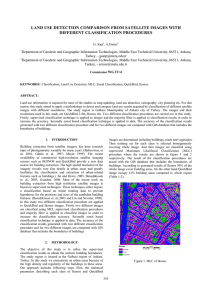3D CITY MODELING FROM HIGH-RESOLUTION SATELLITE IMAGES
advertisement
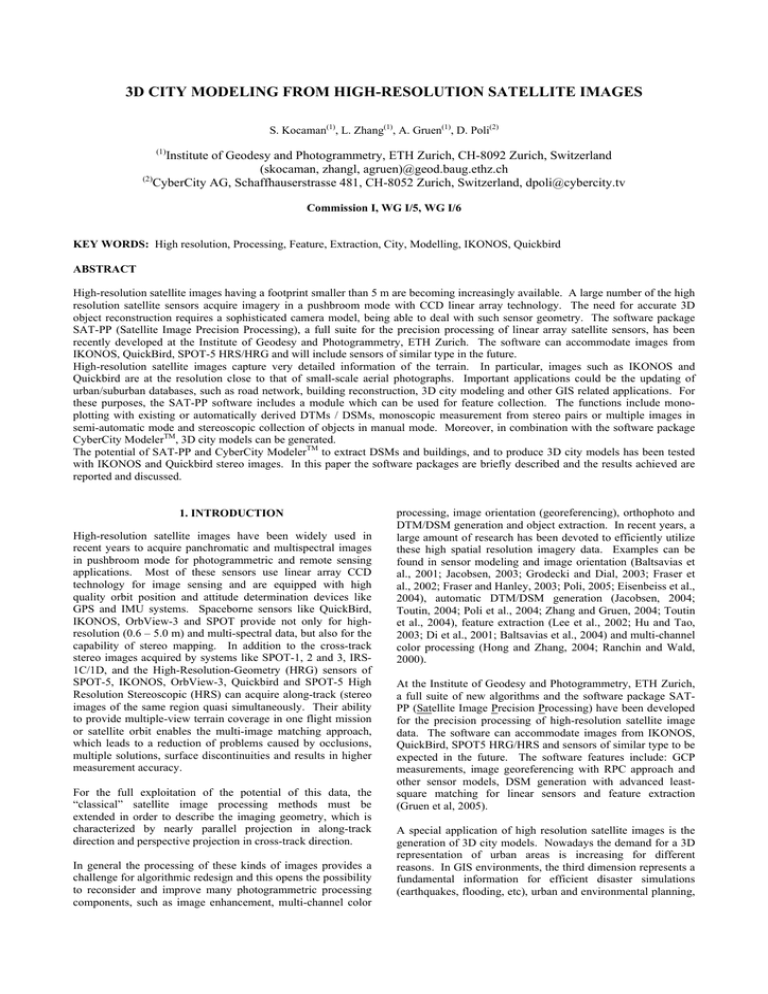
3D CITY MODELING FROM HIGH-RESOLUTION SATELLITE IMAGES S. Kocaman(1), L. Zhang(1), A. Gruen(1), D. Poli(2) (1) Institute of Geodesy and Photogrammetry, ETH Zurich, CH-8092 Zurich, Switzerland (skocaman, zhangl, agruen)@geod.baug.ethz.ch (2) CyberCity AG, Schaffhauserstrasse 481, CH-8052 Zurich, Switzerland, dpoli@cybercity.tv Commission I, WG I/5, WG I/6 KEY WORDS: High resolution, Processing, Feature, Extraction, City, Modelling, IKONOS, Quickbird ABSTRACT High-resolution satellite images having a footprint smaller than 5 m are becoming increasingly available. A large number of the high resolution satellite sensors acquire imagery in a pushbroom mode with CCD linear array technology. The need for accurate 3D object reconstruction requires a sophisticated camera model, being able to deal with such sensor geometry. The software package SAT-PP (Satellite Image Precision Processing), a full suite for the precision processing of linear array satellite sensors, has been recently developed at the Institute of Geodesy and Photogrammetry, ETH Zurich. The software can accommodate images from IKONOS, QuickBird, SPOT-5 HRS/HRG and will include sensors of similar type in the future. High-resolution satellite images capture very detailed information of the terrain. In particular, images such as IKONOS and Quickbird are at the resolution close to that of small-scale aerial photographs. Important applications could be the updating of urban/suburban databases, such as road network, building reconstruction, 3D city modeling and other GIS related applications. For these purposes, the SAT-PP software includes a module which can be used for feature collection. The functions include monoplotting with existing or automatically derived DTMs / DSMs, monoscopic measurement from stereo pairs or multiple images in semi-automatic mode and stereoscopic collection of objects in manual mode. Moreover, in combination with the software package CyberCity ModelerTM, 3D city models can be generated. The potential of SAT-PP and CyberCity ModelerTM to extract DSMs and buildings, and to produce 3D city models has been tested with IKONOS and Quickbird stereo images. In this paper the software packages are briefly described and the results achieved are reported and discussed. 1. INTRODUCTION High-resolution satellite images have been widely used in recent years to acquire panchromatic and multispectral images in pushbroom mode for photogrammetric and remote sensing applications. Most of these sensors use linear array CCD technology for image sensing and are equipped with high quality orbit position and attitude determination devices like GPS and IMU systems. Spaceborne sensors like QuickBird, IKONOS, OrbView-3 and SPOT provide not only for highresolution (0.6 – 5.0 m) and multi-spectral data, but also for the capability of stereo mapping. In addition to the cross-track stereo images acquired by systems like SPOT-1, 2 and 3, IRS1C/1D, and the High-Resolution-Geometry (HRG) sensors of SPOT-5, IKONOS, OrbView-3, Quickbird and SPOT-5 High Resolution Stereoscopic (HRS) can acquire along-track (stereo images of the same region quasi simultaneously. Their ability to provide multiple-view terrain coverage in one flight mission or satellite orbit enables the multi-image matching approach, which leads to a reduction of problems caused by occlusions, multiple solutions, surface discontinuities and results in higher measurement accuracy. For the full exploitation of the potential of this data, the “classical” satellite image processing methods must be extended in order to describe the imaging geometry, which is characterized by nearly parallel projection in along-track direction and perspective projection in cross-track direction. In general the processing of these kinds of images provides a challenge for algorithmic redesign and this opens the possibility to reconsider and improve many photogrammetric processing components, such as image enhancement, multi-channel color processing, image orientation (georeferencing), orthophoto and DTM/DSM generation and object extraction. In recent years, a large amount of research has been devoted to efficiently utilize these high spatial resolution imagery data. Examples can be found in sensor modeling and image orientation (Baltsavias et al., 2001; Jacobsen, 2003; Grodecki and Dial, 2003; Fraser et al., 2002; Fraser and Hanley, 2003; Poli, 2005; Eisenbeiss et al., 2004), automatic DTM/DSM generation (Jacobsen, 2004; Toutin, 2004; Poli et al., 2004; Zhang and Gruen, 2004; Toutin et al., 2004), feature extraction (Lee et al., 2002; Hu and Tao, 2003; Di et al., 2001; Baltsavias et al., 2004) and multi-channel color processing (Hong and Zhang, 2004; Ranchin and Wald, 2000). At the Institute of Geodesy and Photogrammetry, ETH Zurich, a full suite of new algorithms and the software package SATPP (Satellite Image Precision Processing) have been developed for the precision processing of high-resolution satellite image data. The software can accommodate images from IKONOS, QuickBird, SPOT5 HRG/HRS and sensors of similar type to be expected in the future. The software features include: GCP measurements, image georeferencing with RPC approach and other sensor models, DSM generation with advanced leastsquare matching for linear sensors and feature extraction (Gruen et al, 2005). A special application of high resolution satellite images is the generation of 3D city models. Nowadays the demand for a 3D representation of urban areas is increasing for different reasons. In GIS environments, the third dimension represents a fundamental information for efficient disaster simulations (earthquakes, flooding, etc), urban and environmental planning, building monitoring, telecommunication planning, pollution distribution analysis, microclimate investigations, security evaluation, and others. In the field of visualization, the addedvalue provided by a 3D object in comparison to the corresponding 2D plan is incommensurable. By flying through the 3D city models the user can recognize the location and get the true impression of the height of the buildings around him. In particular for applications where the building details are not relevant, very high resolution satellite images can supply a powerful data for the generation of block models or even models with the main roof structures. For higher levels of details (detailed roof structures), aerial images or dense lidar data are required. For the generation of 3D city models different software and approaches are available. Among them, CyberCity ModelerTM (CCM) represents a successful solution for semi-automated object extraction and modeling of built-up environments from images of satellite, aerial and terrestrial platforms. It allows to model not only buildings, but all objects of interest which can be represented as polyhedral model, which includes DTMs, roads, waterways, parking lots, bridges, trees and so forth (even ships have been modeled). As such it produces 3D city models efficiently, with a high degree of flexibility with respect to metric accuracy, modeling resolution (level of detail), type of objects and processing speed. The basic algorithm and related projects have been previously reported in (Gruen and Wang, 2001). Stereoscopic checking of the automatically matched features (f) Generation of orthorectified images (g) Mono-plotting functions with existing or automatically derived DTMs. Stereoscopic measurement and collection of objects with particular emphasis on 3D city modeling by using the semi-automatic 3D modeling software CyberCity ModelerTM (h) Pansharpening image generation to enhance the visual information of multispectral imagery by fusing it with the detailed spatial information of panchromatic imagery. Fully automated sub-pixel image registration between multispectral and panchromatic imagery In this paper the work carried out using SAT-PP and CCM software packages for the extraction and generation of DSMs and 3D objects from IKONOS and Quickbird images are presented and discussed. Figure 1: Workflow of the SAT-PP software system 2. GEOMETRIC PROCESSING OF SATELLITE IMAGES 2.2 Detailed DSM Generation for Feature Collection 2.1 SAT-PP Fundamentals The mathematical description of the sensor model and block adjustment developed in SAT-PP is given in Baltsavias et al. (2005) and Gruen et al. (2005). The software package SAT-PP consists of the following components (Figure 1): (a) User interface for project and data management, image format conversion and pre-processing (with an edgepreserving smoothing filter) and, image display / roaming in mono and stereo modes (b) Sensor models (rigorous and generalized ones such as the rational function model, affine projection model and projective direct linear transformation model) adjusted to the high-resolution Linear Array sensor geometry (c) Orientation of single stereo models and triangulation of larger units. On-line quality control and error analysis via interaction of graphics elements. Ground control point (GCP) and tie point measurement in manual and semiautomated modes (d) Derivation of quasi-epipolar images for stereo mapping and feature collection (e) Automated generation of Digital Surface Models (DSMs) by using a precise and robust image matching approach. The image matching approach for automatic DSM generation from linear array sensors developed in SAT-PP has the ability to provide dense, precise, and reliable results. The approach uses a coarse-to-fine hierarchical solution with an effective combination of several image matching algorithms and automatic quality control. The new characteristics provided by the IKONOS and Quickbird imaging systems, i.e. the multipleview terrain coverage and the high quality image data, are also efficiently utilized in this approach. The approach was originally developed for multi-image processing of the very high-resolution TLS/StarImager aerial Linear Array images (Gruen and Zhang, 2003). Now it has been extended and has the ability to process other linear array images as well. For details of this matching approach and more results, please refer to (Gruen and Zhang, 2003), (Zhang and Gruen, 2004) and (Zhang, 2005). 2.3 Semi-automated Feature Extraction Images such as IKONOS and Quickbird are at a resolution close to that of small-scale aerial photographs. Important applications could be the updating of urban/suburban databases, such as road network, building reconstruction, 3D city modeling and other GIS applications. For these purposes, a module in SAT-PP can be used for feature collection. The functions include mono-plotting with existing or automatically derived DTMs / DSMs, monoscopic measurement from stereo pairs or multiple images in semi-automatic mode and stereoscopic collection of objects in manual mode. With the monoscopic / stereoscopic measurement software, the buildings, roads and other kinds of man-made objects can be measured manually or semi-automatically. Given the DSM / DTM data, some objects like roads can be measured with the mono-plotting module by just using single images. In the current implementation, a semi-automatic method is available for some kinds of objects like buildings, roads and rivers. With this method, the user only needs to measure, for example, the outlines of buildings in one image. The correspondences of building outlines in other images are computed by using the Geometrically Constrained Cross-Correlation (GC3) method (see Zhang, 2005 for details), where the automatically generated DTM is employed as approximation. One example of building extraction is shown in Figure 2. quality to be achieved: 1. generic texturing from a library (if no other data are available) 2. Automatic texturing from aerial (oblique) images if georeferenced before 3. Manual texturing from terrestrial images. More technical details are described in (Ulm, 2003). In this study the input measurements and orientation data for CC-Modeler were generated in SAT-PP, as explained in the following paragraphs. Figure 3. Processing chain in CC-Modeler for 3D city modelling. Figure 2: An extracted building from an IKONOS stereopair. The left building is measured manually and the right one is matched automatically. The current software allows the user to measure point, line, and polygon objects. The matched objects in the target images are displayed simultaneously, and user intervention is possible for editing the polygon/line nodes when mismatching occurs. 2.4 3D City Modeling by CCM The software package CyberCity ModelerTM (CCM) by CyberCity AG allows the generation, editing, management and visualization of 3D city models from aerial images, laser scanner data and satellite images in a semi-automatic mode. It consists of software modules for each main operation. In case of aerial and satellite images (Figure 3), the relevant roof points are firstly measured 3-dimensionally in a photogrammetric station following specific rules, and then they are imported as a point cloud and automatically fitted with roof faces. For common types of roof that follow geometric constraints like right angles and parallel lines etc., intelligent measurement rules were developed to reduce the number of points that are required to be measured to create an object. The measurements are independent of the photogrammetric workstation: the only requirement is that specific technical rules are followed. The building walls extrude from the vertical intersection of the roof vertices on the Digital Terrain Model or alternatively through back projection of the building footprints from the cadastre. In the latter case, overhanging eaves are automatically generated. Special modules for quality control allow for the improvement of the geometry (e.g. right angles, parallel lines, planar faces, correction of overlappings and gaps). It is also possible to introduce geometric attributes like area, volume and compute them automatically for any buildings of interest. Roofs are textured automatically using aerial images, orthophotos or satellite images. For facade texturing, three methods can be followed, according to the available data and the rendering 3. 3D OBJECT EXTRATION FROM IKONOS 3.1 Input Data & Pre-processing The semi-automated feature extraction module of the SAT-PP software package is used to generate a 3D city model from an IKONOS stereopair. The images were acquired over the Melbourne testfield in July 2000. An area of 7x7 km is covered, with an elevation range of less than 100 m. As indicated in Table 1, the sensor and sun elevation angles for the stereopair, imaged in winter, were less than optimal. Apart from the right stereo image, the azimuths of sensor and sun differed considerably, leading to strong shadows in non-occluded areas. More information on the dataset can be found in (Fraser et al., 2002). Table 1: Acquisition parameters for the 1-m Ikonos Geo panchromatic images of the Melbourne testfield (Fraser et al., 2002). Left stereo Right stereo Date, time (local) 16/7/2000, 16/7/2000, 09:53 09:53 136.7 71.9 Sensor azimuth (°) 61.4 60.7 Sensor elevation (°) 38.2 38.3 Sun azimuth (°) 21.1 21.0 Sun elevation (°) In order to do image georeferencing, a certain number of GCPs and tie points have to be collected. With SAT-PP, these points can be measured manually, semi-automatically or fully automatically (only for tie points). Within the study area, there are 32 GPS-surveyed ground control points (GCPs), all being road roundabouts (see Figure 4). Ellipse fitting methods are suitable for GCP measurements over suburban or urban areas. In our software, we follow the method described in (Hanley and Fraser, 2001) and determine the center of each of the roundabouts by measuring six or more edge points around the circumference of the feature in the image. Least squares template matching is performed in order to achieve sub-pixel accuracy of these edge points, and finally a best-fitting ellipse is computed by least-squares to determine the ellipse centers. Once the point is determined in one image, its conjugate points in other images can be computed by least squares matching with also sub-pixel accuracy. The IKONOS stereo pair orientation was based on the supplied RPCs parameters (from Space Imaging) plus additional 6 affine transformation parameters in image space. As results, the RMSEs of orientation are 0.4 meters in planimetry and 0.9 meters in height. Figure 4: GCP measurement in image space, where the point is determined by ellipse fitting method in one image and its conjugate points are computed with least squares matching. Note that the rectangles inside are used to show reshaping effects and they do not correspond to the real matching windows. The object coordinates and the symbols were imported into CCM, and the buildings and the roads are constructed in 3D. The generated city model can be seen in Figures 6a and 6b, from two different viewing angles. (a) 3.2 Generated 3D City Model After the image georeferencing, a DTM of the area has been produced as a base for feature extraction. Buildings and roads are measured in a selected image area, having relatively large buildings. Very small buildings are difficult to recognize due to the resolution. The user-interface for semi-automated feature collection and a general view of the application area can be seen in Figure 5. (b) Figure 6 (a,b): Visualization of the generated 3D city model from two different viewing angles. 4. 3D CITY MODELING FROM QUICKBIRD Figure 5: User-interface for semi-automated feature collection. The upper window shows the results of semi-automated road and building extraction from an IKONOS stereopair in Melbourne. The lower window shows a smaller part of the area with emphasis on an extracted building. The outline of a building was measured in the left image and its correspondence in the right image was computed through automatic image matching. The potential of Quickbird for 3D city modelling was tested in collaboration with Eurimage S.p.A., Italy. Eurimage provided two stereo images over their testsite in Phoenix, Arizona, together with a DTED2 DTM and 30 GCPs measured with topographic surveying. The images were acquired on 9th of April, 2004, with viewing angle 29° (forward) and –27° (backward). The mean ground resolution was 70 cm. In these images it is possible to distinguish both skyscrapers and residential houses distributed fairly regularly (Figure 7). After orienting the images with SAT-PP, the roof points in the downtown are (about 2 km2) were measured in stereo mode and transformed into 3D objects in CC-Modeler. The roof texturing was added automatically using the original Quickbird images. As the facades were not visible in the scenes and no other data were availabla (oblique aerial images, terrestrial images), some facades have been mapped with texture available in the software library. For visualization, TerrainView software by ViewTec (ViewTec, 2006) was used. Two screenshots of the resulting 3D model are shown in Figure 8. One major advantage of the semi-automatic approach is the availability of online editing and instant control of the user on the measurement success. For the line and polygon objects, manual measurement of the individual nodes is possible. Another advantage of semi-automatic object measurement is to define different object types. User interaction is necessary especially for the different building/roof types. The CCM software requires the knowledge of roof styles and their detail points in advance. The semi-automatic feature extraction method of the SAT-PP and its combination with CCM is tested using an IKONOS stereopair acquired over the Melbourne testfield and a Quickbird stereopair over Phoenix, Arizona. Figure 7. Detail of a Quickbird 70-cm resolution image (Courtesy of Eurimage S.p.A., Italy) The tools of SAT-PP allowed the stereo-measurements of some points on the roofs in order to generate a 3D city model with CCM. Additional features of CCM allow roof and facade texturing. The results show that building models with a main roof structures can be successfully extracted by high resolution satellite images like IKONOS (1 m ground resolution) and Quickbird (0.70 m resolution). As expected, with Quickbird more details are visible due to the higher image resolution. Features and 3D models extracted by this data can provide advantages in different geomatic applications, where the main building / roof structure is required. For example, 3D objects extracted by IKONOS and Quickbird can represent an important layer in GIS databases for natural disaster simulation, telecomunication planning (i.e. positioning of antennas), microclimate analysis, real estate and homeland security. REFERENCES Baltsavias, E. P., M. Pateraki, L. Zhang, 2001. Radiometric and Geometric Evaluation of IKONOS Geo Images and Their Use for 3D Building Modeling, Proc. Joint ISPRS Workshop on "High Resolution Mapping from Space 2001", 19-21 September, Hannover, Germany (on CD-ROM). Figure 8. 3D city model generated with CC-Modeler from Quickbird images. Vizualization in TerrainView by ViewTec (Courtesy of Eurimage S.p.A., Italy). 5. CONCLUSIONS High resolution satellites capture detailed information of the terrain. However, due to their special sensor model and imaging conditions, new algorithms or re-design of the existing ones are necessary for processing their imagery. A set of data processing methods and algorithms have been developed and implemented in our in-house software, called SAT-PP. In addition to its sophisticated image pre-processing algorithms, a set of sensor models are available to the user. An image matching approach, which in principle is applicable to any type of linear array imagery, is developed for DSM generation and feature extraction from high resolution satellite images. The manual and semi-automatic feature extraction capability of our software provides a good basis also for 3D city modeling applications with CyberCity- Modeller (CCM). Baltsavias, E. P., L. O’Sullivan, C. Zhang, 2004. Automated Road Extraction and Updating using the ATOMI System – Performance Comparison between Aerial Film, ADS40, IKONOS and QuickBird Orthoimagery, International Archives of Photogrammetry and Remote Sensing, 35 (B4):1053-1058. Baltsavias, E., L. Zhang, H. Eisenbeiss, 2005. DSM Generation and Interior Orientation Determination of IKONOS Images Using a Testfield in Switzerland, ISPRS Hannover Workshop 2005 on “High-Resolution Earth Imaging for Geospatial Information”, 77-20 May, Hannover, Germany(on CD-ROM). Di, K., R. Ma, R. Li, 2001. Deriving 3-D Shorelines from High Resolution IKONOS Satellite Images with Rational Functions, Proceedings of ASPRS Annual Convention 2001, 25-27 April, St. Louis, Missouri (on CD-ROM). Eisenbeiss, H., E. P. Baltsavias, M. Pateraki, L. Zhang, 2004. Potential of IKONOS and QUICKBIRD Imagery for Accurate 3D-Point Positioning, Orthoimage and DSM Generation, International Archives of Photogrammetry and Remote Sensing. 35 (B3):522-528. Fraser, C., E. P. Baltsavias, A. Gruen, 2002. Processing of IKONOS Imagery for Sub-meter 3D Positioning and Building Extraction, ISPRS Journal of Photogrammetry & Remote Sensing, 56(3):177-194. Toutin, Th., 2004. Comparison of Stereo-Extracted DTM from Different High-Resolution Sensors: SPOT-5, EROS-A, IKONOS-II, and QuickBird, IEEE Transactions on Geoscience and Remote Sensing, 42(10): 2121-2129. Fraser, C., H. B. Hanley, 2003. Bias Compensation in Rational Functions for IKONOS Satellite Imagery, Photogrammetric Engineering and Remote Sensing, 69(1):53-57. Toutin, Th., P. Briand, R. Chenier, 2004. DTM Generation from SPOT5 HRS In-Track Stereo Images, International Archives of Photogrammetry and Remote Sensing, 35(B1): 416-420. Grodecki, J., G. Dial, 2003. Block Adjustment of HighResolution Satellite Images Described by Rational Polynomials, Photogrammetric Engineering and Remote Sensing, 69(1):5968. Gruen, A., X. Wang, 2001. News from CyberCity Modeler, In E. Baltsavias, A. Gruen, L. Van Gool (Eds.) Automatic Extraction of Man-made Objects from Aerial and Space Images (III), pp. 93-101. Gruen, A., L. Zhang, 2003. Automatic DTM generation from TLS data, Optical 3-D Measurement Techniques VI, Vol. I, pp. 93-105. Gruen, A., Zhang, L., Eisenbeiss, H., 2005. 3D Precision Processing Of High Resolution Satellite Imagery, ASPRS 2005Annual Conference, Baltimore, Maryland, USA, March 7-11, on CD-ROM. Hanley, H. B., Fraser, C. S., 2001. Geopositioning Accuracy of IKONOS Imagery: Indications from 2D Transformations. Photogrammetric Record, 17 (98):317-329. Hong, G., Y. Zhang, 2004. The Effects of Different Types of Wavelets on Image Fusion, International Archives of Photogrammetric and Remote Sensing, 35 (B4):915-920. Hu, X., C. V. Tao, 2003. Automatic Extraction of Main-Road Centerlines from IKONOS and Quick-Bird Imagery Using Perceptual Grouping, Proceedings of ASPRS Annual Convention 2003, 5-9 May, Anchorage, Alaska (on CD-ROM). Jacobsen K., 2003. Geometric Potential of IKONOS- and QuickBird-Images, In D. Fritsch (Ed.) Photogrammetric Weeks ‘03, pp. 101-110. Jacobsen K., 2004. DTM Generation by SPOT5 HRS, International Archives of Photogrammetry and Remote Sensing, 35(B1):439-444. Lee, D. S., J. Shan, J. S. Bethel, 2002. Class-Guided Building Extraction from IKONOS Imagery, Photogrammetric Engineering and Remote Sensing, 69(2): 143-150. Poli, D., L. Zhang, A. Gruen, 2004. SPOT-5/HRS Stereo Image Orientation and Automatic DSM Generation, International Archives of Photogrammetry and Remote Sensing, 35(B1):421232. Poli, D., 2005. Modelling of Spaceborne Linear Array Sensors, Ph. D. Dissertation, IGP Report No. 85, ISSN 0252-9335 ISBN 3-906467-3, Institute of Geodesy and Photogrammetry, ETH Zurich, Switzerland. Ranchin, T., L. Wald, 2000. Fusion of High Spatial and Spectral Resolution Images: The ARSIS Concept and its Implementation, Photogrammetric Engineering and Remote Sensing, 66(1):49-61. Ulm, K., 2003. Reality-based 3D city models with CyberCityModeler (CC-Modeler™) and laserscanner data. VI Conference on Optical 3D Measurement Techniques - Gruen/Kahmen (Eds), Vol.2, pp. 32-39, September 2003, Zurich, Switzerland. Viewtec, 2006. http://www.viewtec.ch (last visited January 2006). Zhang, L., A. Gruen, 2004. Automatic DSM Generation from Linear Array Imagery Data, International Archives of Photogrammetry and Remote Sensing, 35(B3): 128-133. Zhang, L., 2005. Automatic Digital Surface Model (DSM) Generation from Linear Array Images, Ph. D. Dissertation, Report No. 88, Institute of Geodesy and Photogrammetry, ETH Zurich, Switzerland. 206 p. ACKNOWLEDGEMENTS The authors would like to thank Prof. Fraser, Department of Geomatics, University of Melbourne and Mr. Volpe, Eurimage S.p.A. for provision of IKONOS and Quickbird imagery and ground control information. Dr. Wang, CyberCity AG is gratefully acknowledged for his support.
